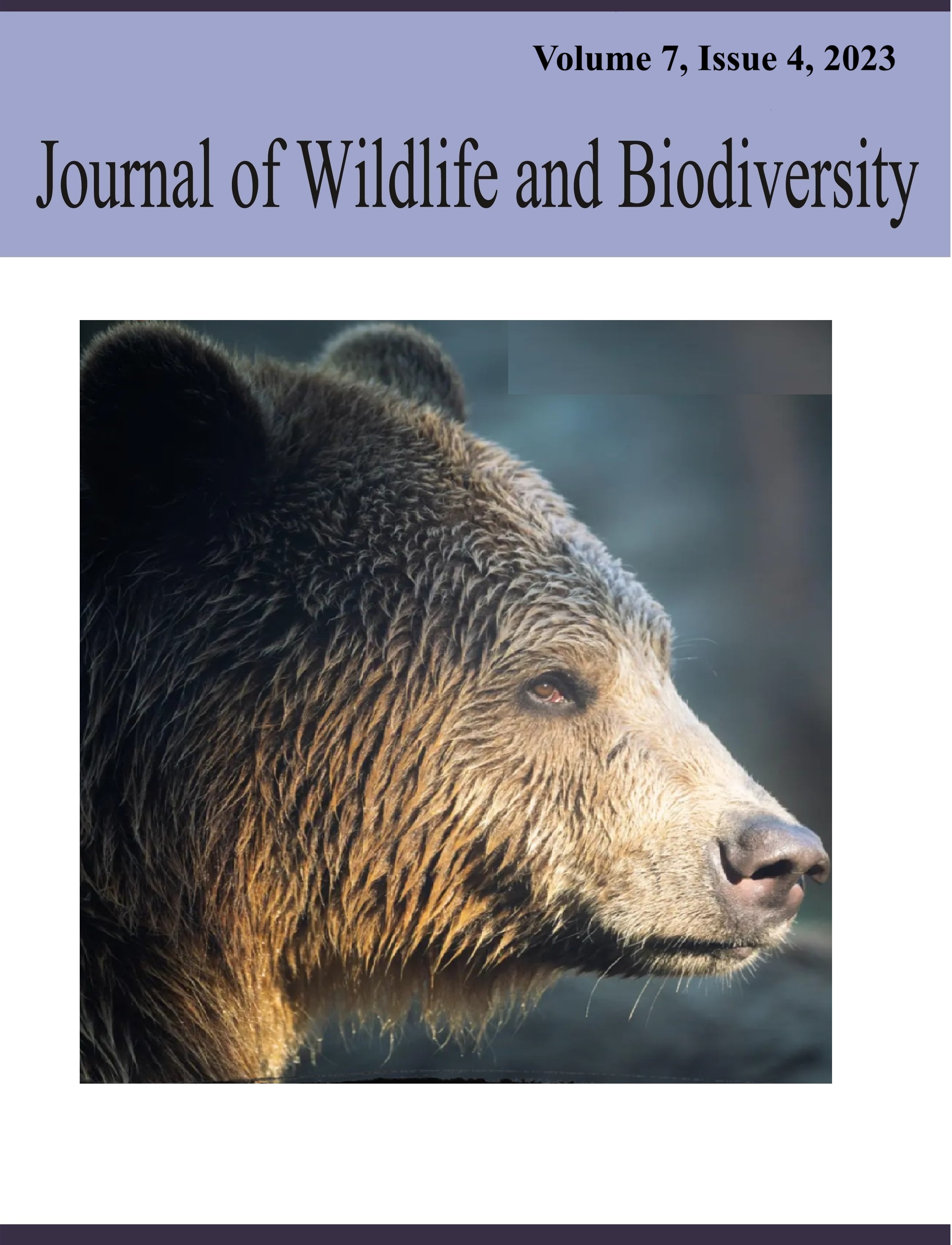Genetic documentation of snake species using non-invasive sampling and non-toxic DNA isolation method
Genetic documentation of snake
DOI:
https://doi.org/10.5281/zenodo.7048818Keywords:
Exuviates, Phylogeny, reptilian, taxonomy , Darreh-Anjir Wildlife RefugeAbstract
Despite the knowledge of the evolution of snakes worldwide, snake phylogeny requires a more detailed approach in South India. Molecular taxonomic approaches using DNA barcoding are a molecular tool frequently in species identification as well as studies of phylogenetics. Here, a non-invasive genetic sampling method using skin exuviates was used. This method is often overlooked for molecular studies of reptiles. We isolated DNA using a non-toxic method from skin exuviates collected from Chennai Snake Park and screened for the cytochrome oxidase subunit I (COI) region of mitochondria. Samples that were amplified successfully were barcoded. A total of seven species of snakes were identified which belonged to 5 families. We combined and compared sequences of these seven-snake species from other countries to construct a phylogenetic tree and examined the genetic distance within species and families. This depiction and analysis showed a high degree of genetic variability intra-specifically between the South Indian samples to the samples from other parts of the world. This study documents how skin exuviates of snakes and the polymerase chain reaction of the COI region can be used for DNA barcoding and estimating phylogenetic relationships among snake species. Overall, this method is very versatile, inexpensive, and non-toxic which can help in understanding the evolution and phylogeny of snakes to formulate proper strategies for the conservation of snake species.
References
Burbrink, F.T., Crother, B. I. (2011). Evolution and taxonomy of snakes. Reproductive biology and phylogeny of snakes, 9.
Carroll, E.L., Bruford, M.W., DeWoody, J. A., Leroy, G., Strand, A., Waits, L., Wang, J. (2018). Genetic and genomic monitoring with minimally invasive sampling methods. Evolutionary Applications, 11(7),1094-1119.
Chaves, A.V., Clozato, C.L., Lacerda, D.R., Sari, E.H.R., Santos, F. R. (2008). Molecular taxonomy of Brazilian tyrant‐flycatchers (Passeriformes: Tyrannidae). Molecular Ecology Resources, 8(6),1169-1177.
Clark, A. 1998. Reptile sheds yield high-quality DNA. Herpetological Review, 29(1), 17-17.
Dubey, B., Meganathan, P. R., Haque, I. (2011). DNA mini-barcoding: an approach for forensic identification of some endangered Indian snake species. Forensic Science International: Genetics, 5(3),181-184.
Fetzner Jr, J.W. (1999). Extracting high-quality DNA from shed reptile skins: a simplified method. Biotechniques, 26(6),1052-1054.
Figueroa, A., McKelvy, A. D., Grismer, L. L., Bell, C. D., Lailvaux, S. P. (2016). A species-level phylogeny of extant snakes with description of a new colubrid subfamily and genus. PloS one, 11(9), e0161070.
Hall, T.A. 1999. BioEdit: A user‐friendly biological sequence alignment editor and analysis program for Windows 95/98/NT. Nucl Acids Symp Ser, 41,95-98.
Hebert, P.D., Ratnasingham, S., De Waard, J.R. (2003). Barcoding animal life: cytochrome c oxidase subunit 1 divergence among closely related species. Proceedings of the Royal Society of London. Series B: Biological Sciences. 270(suppl_1), S96-S99.
Kelly, C.M., Barker, N.P., Villet, M.H. (2003). Phylogenetics of advanced snakes (Caenophidia) based on four mitochondrial genes. Systematic Biology, 52(4),439-459.
Khedkar, G.D., Jamdade, R., Naik, S., David, L., Haymer, D. (2014) DNA Barcodes for the FIshes of the Narmada, One of India’s Longest Rivers. PLoS ONE, 9, e101460. doi: 10.1371/journal.pone.0101460
Khedkar, T., Sharma, R., Tiknaik, A., Khedkar, G., Naikwade, B. S., Ron, T. B., & Haymer, D. (2016). DNA barcoding using skin exuviates can improve the identification and biodiversity studies of snakes. Mitochondrial DNA Part A, 27(1),499-507.
Kimura M. (1980). A simple method for estimating evolutionary rates of base substitutions through comparative studies of nucleotide sequences. Journal of Molecular Evolution, 16(2),111-120.
Kumar S, Stecher G, Li M, Knyaz C, Tamura K. (2018). MEGAX: molecular evolutionary genetics analysis across computing platforms. Molecular Biology and Evolution, 35:1547-1549.
Kundu, S., Lalremsanga, H. T., Rahman, M. M., Ahsan, M. F., Biakzuala, L., Kumar, V., Siddiki, A. Z. (2020). DNA barcoding elucidates the population genetic diversity of venomous cobra species (Reptilia: Elapidae) in the Indo-Bangladesh region. Mitochondrial DNA Part B, 5(3):2525-2530.
Laopichienpong, N., Muangmai, N., Supikamolseni, A., Twilprawat, P., Chanhome, L., Suntrarachun, S., ... & Srikulnath, K. (2016). Assessment of snake DNA barcodes based on mitochondrial COI and Cytb genes revealed multiple putative cryptic species in Thailand. Gene, 594(2),238-247.
Mills, L.S., Citta, J.J., Lair, K. P., Schwartz, M.K., & Tallmon, D. A. (2000). Estimating animal abundance using noninvasive DNA sampling: promise and pitfalls. Ecological Applications, 10(1),283-294.
Nagy, Z. T., Sonet, G., Glaw, F., & Vences, M. (2012). First large-scale DNA barcoding assessment of reptiles in the biodiversity hotspot of Madagascar, based on newly designed COI primers. PloS one, 7(3), e34506.
Rambaut A. 2012. FigTree v.1.4.2: Tree Figure Drawing Tool. Available online at: http://tree.bio.ed.ac.uk/software/figtree.
Rajpoot, A., Kumar, V. P., Bahuguna, A., & Rasaily, S. S. (2021). Preliminary genetic documentation of snake species through shed skin from Uttarakhand, India: A non-invasive genetic sampling approach. Journal of wildlife and Biodiversity, 5(1), 81-91.
Ratnarathorn, N., Harnyuttanakorn, P., Chanhome, L., Evans, S. E., Day, J. J. (2019). Geographical differentiation and cryptic diversity in the monocled cobra, Naja kaouthia (Elapidae), from Thailand. Zoologica Scripta, 48(6),711-726.
Slowinski, J.B., Lawson, R. (2002). Snake phylogeny: evidence from nuclear and mitochondrial genes. Molecular Phylogenetics and Evolution, 24(2),194–202.
Taggart, J.B., Hynes R. A., Prodohl P.A., Fergus A. (1992) A simplified protocol for routine total DNA isolation fromsalmonid fishes. Journal of Fish Biology, 40,963-965.
Thomson, J.M. 1997. The Mugillidae of the world. Mem Queensland Mus, 41,457-562.
Downloads
Published
How to Cite
Issue
Section
License
Copyright (c) 2022 Journal of Wildlife and Biodiversity

This work is licensed under a Creative Commons Attribution 4.0 International License.


